The Symbolic Olive in Palestine-Israel
March 29, 2017
To international NGOs and development agencies, peace is often sought through economic cooperation. Olive Oil Without Borders is a program implemented by the Near East Foundation and funded by the U.S. Agency for International Development that does just that.
The goal of the program is to bring together Israeli and Palestinian farmers by training them in effective olive oil production and having them work together in the industry. As shown in the video below, part of the goal is to foster peace in the region and have Israelis and Palestinians gain a greater understanding of one another.
The Palestinian man in the video says he dreams of an “olive peace”. It is fitting that the olive tree/olive branch is a symbol of peace, and that this program is using just that as its symbol. However, the history of olive trees in the region is not a peaceful one, and the symbol of an olive tree carries much more weight.
Multiple times, Israel has uprooted olive trees in Palestine in order to build settlements, pave roads, or further their colonial project in various ways. The symbol in fact embodies a different meaning than peace for many Palestinians. There is a sort of twisted irony that what is supposed to be a symbol of peace is in fact seen as the opposite due to a colonial occupation that is not addressed in the program that seeks to build peace from the symbol of the olive tree.
However, it is worth entertaining the merit of a program that creates tangible change by integrating Palestinians into the economy and facilitating cooperation between the two sides. The question is, how do we create a third space by tackling root problems, but at the same time bringing together both sides in the journey to move forward?
The economic and agricultural cooperation of Israelis and Palestinians through this program can certainly be seen as a valuable third space,especially when tensions are so high that many Israelis and Palestinians have never even worked together. Of course, it is not the lasting and comprehensive solution necessary, and is merely one part of a long process towards justice.
Author: Aastha Uprety
Sources:
http://www.neareast.org/nef-launches-olive-oil-without-borders-iii/
http://www.timesofisrael.com/israel-said-to-uproot-250-olive-trees-in-west-bank-village/
http://www.haaretz.com/no-one-saw-no-one-heard-300-palestinian-olive-trees-uprooted-1.284278
#JewsAndArabsRefuseToBeEnemies
March 29, 2017
Operation Protective Edge occurred in July and August of 2014, and left over 2,000 Palestinians dead, 18,000 homes destroyed and 470,000 Palestinians displaced. Israeli leaders have a history of framing military objective in broad, self-defense terms. Israel’s military action tends to see a location or a ethnicity as an just identification of an enemy. Israel justified the need for this operation because of terrorist rocket fire in early July and the discovery of alleged underground tunnels leading out of Gaza. The reported goal of the mission was to restore security to Israeli citizens and stop Hamas’s militants from using the tunnels to infiltrate Israel. Throughout history, Israeli leaders have used the idea of counter-terrorism to justify mass-killing and demolition that really serves as a demonstration to Arabs to quench any revolt and serve the oppression.
Shortly after the Israeli operation, “Protective Edge,” began in Gaza, a social media campaign was launched by Abraham Gutman and Dania Darwish, a Jewish and Arab student at Hunter College. The campaign had people from all over the world sharing pictures of Jews and Arabs together in peace while using the hashtag #JewsAndArabsRefuseToBeEnemies. The pictures became viral and were shared on different forms of social media.
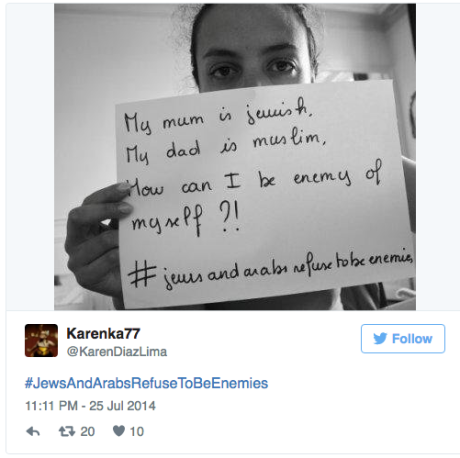
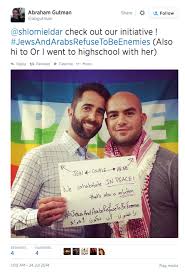
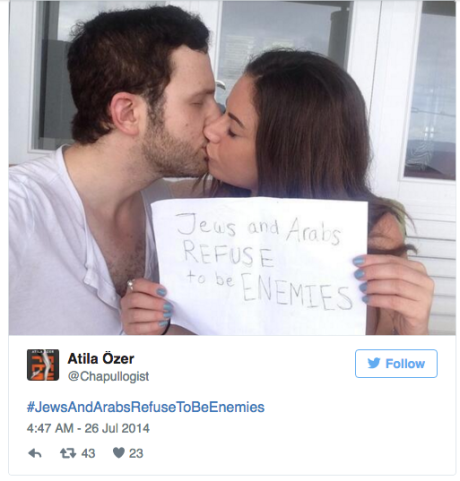
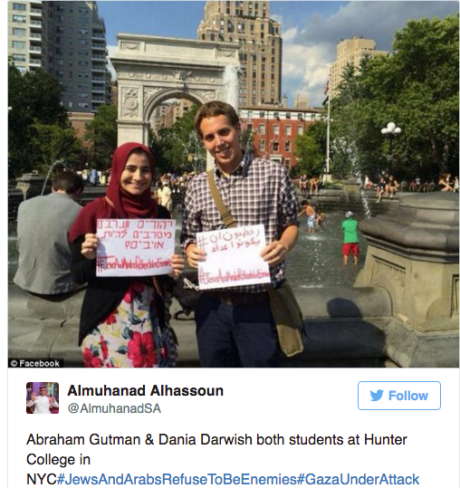

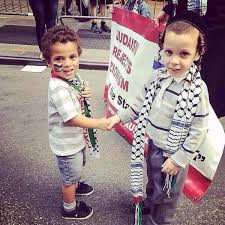

Social media became a kind of third space, where both Jews and Arabs could come together in the idea that humanity is universal and that a hateful state conflict can be worked through if the people on both sides resist giving into fear and continue to see each other as, first and foremost, people. They stand together to demand an end to the racist excuses for violence. The Facebook group allows for a place where people from all sides of the conflict can come together to share and react to news from their own perspectives in a forum with the sole direction of finding lasting peace.
From the “about” section of Facebook
“It is time to take a clear stance on the stereotypes, generalizations and the incitement of hatred! While we may not agree on the political developments of the Arab-Israeli conflict, we must demonstrate that we refuse to be enemies. We stand in solidarity with the Arab and Jewish populations who went to the streets of Israel/Palestine to demonstrate that they refuse to succumb to the hatred sentiments of the minority.We don’t believe that if we will all be friends the core issues will disappear and we don’t have to agree on everything, but we do need to show that we won’t be enemies. If you also refuse to be the enemy of someone you have never met just because of their ethnicity or religion, come join us!
#JewsAndArabsRefuseToBeEnemies”
Sources
https://www.rt.com/news/175792-jews-arabs-refuse-enemies/
https://www.ict.org.il/Article/1262/Operation-Protective-Edge-A-Detailed-Summary-of-Events
Pro(Occupation)paganda
March 29, 2017
One of Israel’s most successful campaigns alongside its military occupation is that of its occupation propaganda; as the military campaign controls the Palestinians (citizen or not), the media controls the Israelis. While media exposure outside of Israel is increasing its coverage of the conflict, inside, the fight to justify the occupation to the Israeli people rages on (and does so successfully). Working from numerous platforms, such as “A land without a people, for a people without a land,” groups such as the Anti-Defamation League (ADL) “educate and inform about the important security, diplomatic and societal issues confronting Israel.”

*unless you’re Palestinian.
Propaganda portraying Israel’s unquestionable right to Palestinian land is key to keeping the Israeli (Jewish) people on the government’s side, allowing the military occupations to continue. Showcasing support for “the people”, the image such as the one to the right stands as a solid example of many other media images that spin the narrative that all actions committed by Israel are to protect people’s rights, and therefore, any violence committed in the name of protection is acceptable. One such example in particular being violence from the soldiers of the Israel Defense Force (IDF) against Palestinians and those living in occupied territories.

Israel’s “Iron Dome” is a anti-ballistic-missile system meant to deploy interceptor warheads to destroy rockets shot from Gaza into Israel in the air, before they are able to detonate on Israeli soil. Israeli officials have boasted a 90% effectiveness rate, while other experts have said it to be more around 30%.
One such tactic most used in pro-IDF media can be boiled down to, “The Palestinians are committing far more atrocious crimes,” which attempts to absolve Israel of any blame, as they claim that Palestinians are obviously far worse in practice. Keeping nothing less than a glimmering light on the IDF forces, which all Israeli citizens must serve in, has built and maintained the mindset that such service and duty is honorable, without question as to the cost. With such rampant vilifying of the Palestinian people, and an unwavering determination to prolong an achieved ignorance amongst Israeli citizens, bringing them out into a “third space” will be nothing less than a painful process.
Bibliography
https://www.adl.org/what-we-do/israel
Twitter: IDFSpokesperson
Changing the Status Quo
March 16, 2017
“Tiyul-Rihla (“Trip” in Hebrew and Arabic) is a bi-national organization which develops educational opportunities focusing on Palestinian and Israeli historical narratives, cultures, and identities. Our multi-day trips bring mixed groups of Palestinians and Israelis on tours which provide a unique opportunity for participants to learn about each other from each other by exploring the land and the history they share.” Tiyul-Rihla is a group dedicated to overcoming the educational issues between Palestinians and Israelis. As we have seen for a while throughout the course of this class, the Israeli narrative of the story of their country has been the dominant narrative. With the truth being far different from the stories in the history books, a educational organization dedicated to bringing about knowledge and understanding between the two peoples is absolutely vital. In one of the attached articles from the page entitled “Travelling without political baggage” an Israeli making a trip into the West Bank states, “We can’t solve the conflict or bring peace, but we can help pave the way for people to respect the other’s rights – on both sides of the divide. On the most basic level, encounters like this allow us to realise and understand the right for the other to exist. In turn, on a slightly more nuanced level, it allows each side to respect the sovereignty and legitimacy of the other.” Legitimacy being one of the biggest issues that we have talked about during this class, there is an extreme need for both sides to be able to find a way to understand each other’s legitimate right to exist. By organizing trips and tours for people to go on like the one in the aforementioned article, it forces interaction between the two peoples, therefore forcing the legitimacy directly into the open. Through its educational programs, one sees that knowledge is the ultimate form of power when it comes to breaking down the barriers that exist between these two people.
http://chronikler.com/travel/tiyul-rihla/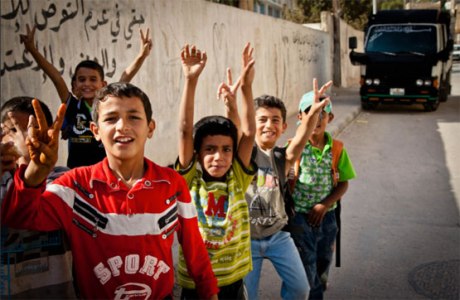
Fighting for the Right to Enter!
March 15, 2017
Right to Enter (RTE) is an Israeli based, grassroots Non-Governmental Organization (NGO) made up of individuals and families (both Israeli and Palestinian) that have been either separated or affected by the physical restrictions of the Israeli/Palestinian conflict. RTE focuses on check points where Israeli authorities deny Palestinians entry/exit to/from Palestinian occupied territory.

RTE has focused the majority of their efforts in spreading awareness of physically divided families and villages to the international community, as well as advocating for Palestinians on an individual basis to the national government. RTE’s other goals include:
- “Contact those still in the country and at risk of being denied re-entry, to advise them what options may be available to them, and to share experience about ways of proactive legal action;
- Collect information and document cases of entry and reentry denial;
- Call on the national and international community to protest and take action against this Israeli practice of family separation and denying entry to foreign experts and supporters;
- Launch an international legal and political campaign to prevent, stop and reverse these Israeli policies and practices;
- Urge consulates and embassies of affected citizens to formally protest, protect and take action against these Israeli practices;
- Publicize the issue and disseminate information through national and international media channels.”

RTE is unique in that it also advocates for foreign workers employed in Palestine that are denied the right to re-enter Palestine after briefly exiting the occupied territories. RTE calls on the governments of foreign workers to press the Israeli government to legally and socially promote the right of return to Palestinians and foreign workers. By making the Palestinian right of return issue every countries issue, RTE hopes to work towards a more peaceful relationship between Israel and Palestine.
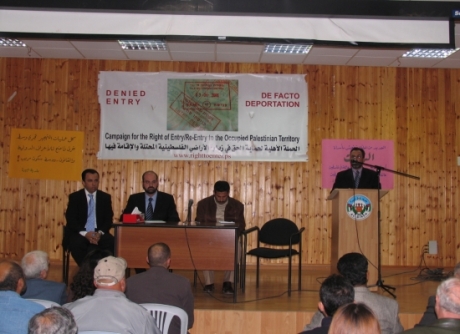
Author: Maggie Dene
Bibliography:
“Take Action.” RTE | Right to Enter. Accessed March 15, 2017. http://www.righttoenter.ps/take-action/.
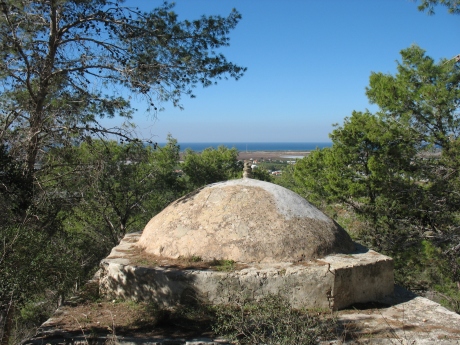 In her book Visual Occupations: Violence and Visibility in a Conflict Zone, author Gil Z. Hochberg discusses the “blinding mechanisms” employed to erase the memory of desolate settlements that were once inhabited by Palestinians until they were forced out during the 1948 Arab-Israeli War. Aside from resignification, the process by which Palestinian ruins are transformed into biblical symbols, the other primary method used by Zionists to remove any trace of Palestinian heritage in Israel is tree planting, which conceals Palestinian ruins from public view. The Jewish National Fund is responsible for creating national forests, along with encouraging Jewish settlement in Palestine. According to the JNF website (found here), the organization has planted more than 240 million trees, covering more than 250,000 acres. While the JNF claims that the mass forestation serves to drain swamps, fertilize the desert, and provide jobs to Jewish immigrants, the new trees also cover up the Palestinian ruins and the memories of expulsion associated with them.
In her book Visual Occupations: Violence and Visibility in a Conflict Zone, author Gil Z. Hochberg discusses the “blinding mechanisms” employed to erase the memory of desolate settlements that were once inhabited by Palestinians until they were forced out during the 1948 Arab-Israeli War. Aside from resignification, the process by which Palestinian ruins are transformed into biblical symbols, the other primary method used by Zionists to remove any trace of Palestinian heritage in Israel is tree planting, which conceals Palestinian ruins from public view. The Jewish National Fund is responsible for creating national forests, along with encouraging Jewish settlement in Palestine. According to the JNF website (found here), the organization has planted more than 240 million trees, covering more than 250,000 acres. While the JNF claims that the mass forestation serves to drain swamps, fertilize the desert, and provide jobs to Jewish immigrants, the new trees also cover up the Palestinian ruins and the memories of expulsion associated with them.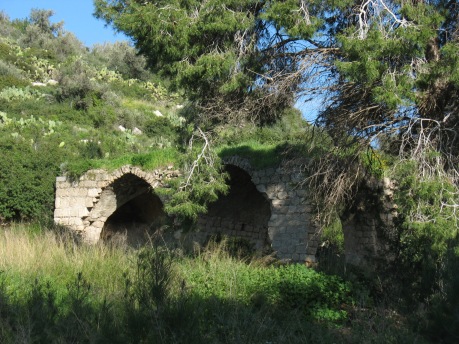
Most trees in these national forests are pine, a type of tree which was not seen in the Middle East before the 20th century. Jewish settlers chose the pine tree for two reasons. First, as a European species, the pine tree helped to familiarize the land, making it seem more European. Second, pine trees grow quickly, making it easier to cover up ruins of Palestinian villages over a shorter amount of time.
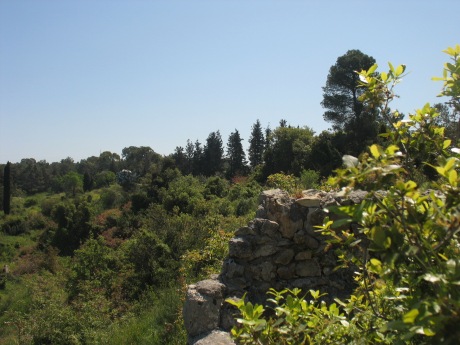
Recently, wildfires have spread throughout many national forests, stimulated by dry weather conditions and strong winds. Additionally, Israel claims that these fires were started intentionally by Palestinian terrorists, and Israeli authorities have made several arrests. Click here to see media coverage of the forest fires from November 24, 2016.
Author: Matthew Jacoby
Bibliography:
“Ethnic Cleansing by All Means: The Real Israeli ‘peace’ Policy.” Mondoweiss. N.p., 18 Oct. 2014. Web. 01 Mar. 2017.
Hochberg, Gil Z. Visual Occupations: Violence and Visibility in a Conflict Zone. Durham: Duke U, 2015. Print.
“Jewish National Fund.” Jewish National Fund: . N.p., n.d. Web. 01 Mar. 2017.
“Palestinian Villages, Israeli Parks: How the Past Echoes in the Present.” Palestine Square | ميدان فلسـطيـن. N.p., 27 Jan. 2017. Web. 01 Mar. 2017.
Times, The New York. “Wildfires Spread Across Northern Israel.” The New York Times. The New York Times, 24 Nov. 2016. Web. 01 Mar. 2017.
Kids4Peace: Love through Understanding
March 1, 2017
Kids 4 Peace is a global movement founded in 2002 which connects and facilitates long-term relationships between children and families of different religions, including Jewish, Christian, and Muslim, Israeli and Palestinian. They run a six-year program called Pathways to Peace which goes from 6th-12th grade, consisting of meetings, camps and leadership programs that focus on interfaith dialogue and nonviolent action.
Kids4Peace is not about looking past the histories and cultures of the other; it is about hearing it and understanding it. It is about honesty and diverse perspectives. It rejects the idea that peace comes from separation, from ignoring the other. Their programs encourage participants to share painful stories, and teach them how to hear these stories without becoming defensive. As one girl in the video said, they meet… become a family, and…forgive the past of [their] religions.”Obviously, the process is much slower and more complex than that, but the roots are evident in such a simplification– conflict resolution comes from love, which can only arise from true understanding of the other. It comes from a willingness and desire to change one’s own views and perspectives, not just defend them. This reflects the principles of reciprocal influence and mutual recognition we have discussed.